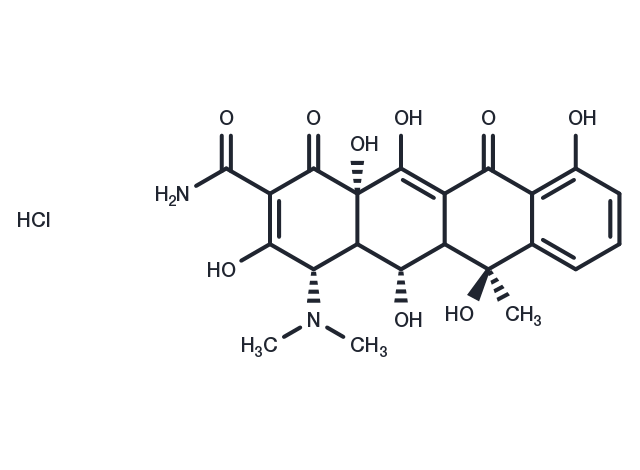Powder: -20°C for 3 years | In solvent: -80°C for 1 year


Oxytetracycline (OTC) is a broad-spectrum antibiotic that acts by inhibiting protein synthesis in bacteria. Oxytetracycline prevents the binding from aminoacil-tRNA to the complex m-ribosomal RNA. Oxytetracycline also possesses anti-HSV-1 activity[1][2][3].

| Pack Size | Availability | Price/USD | Quantity |
|---|---|---|---|
| 5 mg | In stock | $ 50.00 | |
| 10 mg | In stock | $ 75.00 | |
| 25 mg | In stock | $ 128.00 | |
| 50 mg | In stock | $ 192.00 | |
| 100 mg | In stock | $ 287.00 | |
| 200 mg | In stock | $ 431.00 | |
| 1 mL * 10 mM (in DMSO) | In stock | $ 79.00 |

| Description | Oxytetracycline (OTC) is a broad-spectrum antibiotic that acts by inhibiting protein synthesis in bacteria. Oxytetracycline prevents the binding from aminoacil-tRNA to the complex m-ribosomal RNA. Oxytetracycline also possesses anti-HSV-1 activity[1][2][3]. |
| In vitro | Oxytetracycline is an important member of the bacterial aromatic polyketide family, which is a structurally diverse class of natural products. Oxytetracycline is synthesized by a type II polyketide synthase that generates the poly-beta-ketone backbone through successive decarboxylative condensation of malonyl-CoA extender units, followed by modifications by cyclases, oxygenases, transferases, and additional tailoring enzymes[2]. |
| In vivo | For Oxytetracycline, the limits are 100 μg/kg in muscle and milk, 200 μg/kg in egg, 300 μg/kg in liver and 600 μg/kg in kidney. Oxytetracycline (OTC) is administered to fish as medicated feed at concentrations ranging from 35 to 75 mg a.i kg-1 biomass day-1 for 7-14 days[1]. The effects of administration a therapeutic dose of Oxytetracycline (82.8 mg/kg of bw to 1 % bw/day) for 10 days are species specific. Oxytetracycline increases the relative liver weight in Morone chrysops x M. saxatilis, the enzymatic activity of CYP3A4 in Ictalurus punctatus, protein expression of CYP3A4 in Oreochromis niloticus and depleted the hepatic CYP3A4 in the latter[1]. |
| Molecular Weight | 496.895 |
| Formula | C22H25ClN2O9 |
| CAS No. | 423769-22-6 |
Powder: -20°C for 3 years | In solvent: -80°C for 1 year
DMSO: 55 mg/mL (110.69 mM)
You can also refer to dose conversion for different animals. More
bottom
Please see Inhibitor Handling Instructions for more frequently ask questions. Topics include: how to prepare stock solutions, how to store products, and cautions on cell-based assays & animal experiments, etc.
Aquacycline 423769-22-6 Microbiology/Virology HSV inhibitor inhibit
